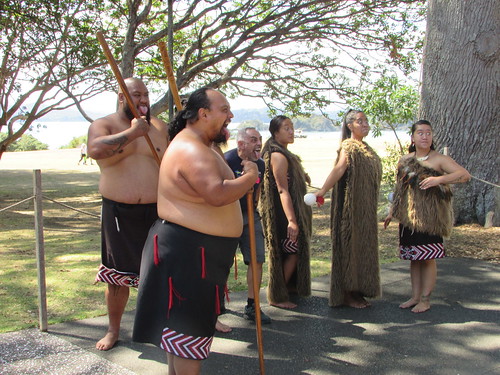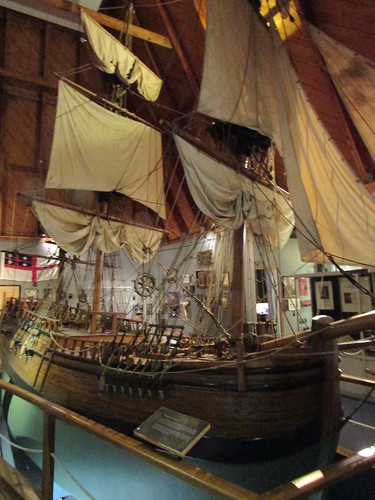Events of Wednesday 12th February 2020
Overnight, the ship had sailed north-west along the coast of New Zealand’s North Island to the area called the Bay of Islands. This is described as “a drowned valley system, 16 km wide and 260 square km in area with 144 islands and numerous peninsulas and inlets”. We anchored offshore and prepared to dispatch the guests to land in the ship’s fleet of Zodiac inflatable boats. This involved a mandatory ‘Zodiac Briefing’ and explanations of the use of the second type of self-inflating lifejacket used on Zodiac transfers.
Disembarkation started at around 8.15 a.m. and it took some time to ferry all the passengers ashore because, rather than take us to the closest township at Russell, Zodiacs were making a longer, exhilarating crossing to the other side of the bay near Waitangi at a location called Ti Point. A modern pier with a floating pontoon allowed a ‘dry landing’. As each Zodiac arrived, guests were directed to one of a number of waiting coaches.

Modern pier near Kerikeri Mission House, Bay of Islands
A short drive took us to the Kerikeri Mission House. In 1819 the Church Missionary Society seeking to spread the Word chose this site by navigating up-river from the Bay of Islands to a suitable site for a wharf allowing them to import all the materials necessary to establish a permanent presence. Adjacent to the wharf they built a substantial stone building which remains open as a shop today as part of the site now in the care of Heritage New Zealand.

The Stone Store at Kerikeri Mission House, Bay of Islands
Nearby stands Kemp House of mainly wooden construction, restored, furnished to represent the period and open daily as a museum. A lady guide, dressed as a storekeeper, told us a little of the history before we explored the house. Because of the age of the building, they only allow up to five visitors on the first floor at a time, so the guide stood at the foot of the stairs with five spurtles (a Scottish stirring stick used when making porridge) which she used to keep track of visitors as she allowed them to the upper floor. The missionaries had chosen the site well: it remains a charming, quiet spot.

Kemp House, Kerikeri Mission House, Bay of Islands
Then it was ‘back on the bus’ for a drive through the undulating, fertile landscape of volcanic soil to the Waitagi Treaty Ground.
The Maori had lived in what is now New Zealand for generations before whalers, European settlers and missionaries started to arrive. Different Maori tribes competed with one another for the trading opportunities these visitors offered. In 1835 a confederation of Maori leaders had signed a Declaration of Independence. But settlers and the New Zealand Company (a similar arrangement to the better-known East India Company) were urging Britain to establish a Colony and the French were also showing interest in the lands.
In 1840, the important Treaty of Waitangi was signed between the British and the Maori giving sovereignty to the British Crown but continued ownership of land by the Maori. The Maori were given full rights and protection as British Subjects but differences in the English and Maori language versions of the Treaty led to long-term disagreements and contributed to the New Zealand Wars between 1845 and 1872. Nonetheless, the Treaty of Waitangi is regarded as the first step in the long road to the creation of modern New Zealand.
We left the coaches at a special gate for parties and an excellent lady Maori Guide led us to the traditional Maori carved meeting house called a Hotunui nearby (similar to the one I’d seen in Auckland Museum the previous day). Here, we watched a cultural performance given by a group of Maori people in traditional dress.

Maori Cultural Performance, Waitangi Treaty Ground, Bay of Islands

Maori Performers, Waitangi Treaty Ground, Bay of Islands
After an opportunity to be photographed with the Maori performers, our guide led us across the grassy headland to James Busby’s home overlooking the headland. This mainly wooden building is now laid out as a most interesting museum.

The view from James Busby’s House at Waitangi Treaty Ground, Bay of Islands

James Busby’s House at Waitangi Treaty Ground, Bay of Islands
Our guide then took us to a long shed near the water housing an incredible, long, traditional Maori canoe designed for over 100 rowers. Because of the length, it was constructed in three sections lashed together.

Maori canoe designed for over 100 rowers, Waitangi Treaty Ground, Bay of Islands
Finally, we walked to the main museum complex, a modern design incorporating video presentation theatre, shop, café and toilets. Slightly apart, I almost missed another modern museum building with two more galleries of historical exhibits which I only had time to ‘skim’ before the meeting time back at the bus.
We then drove back to the pier at Ti Point where we were offered a choice: back to the ship by Zodiac, lunch on board, then take the short Zodiac trip to the town of Russell or stay on the coach to Kerikeri, take the public ferry to Russell and make our own arrangements for lunch. I chose the second option along, I think, with most guests so the coach continued past a beach area where a number of sailboarders powered by parachutes were enjoying themselves and a speedboat circling the bay was hauling a 2-man parasail aloft.

Kerikeri, Bay of Islands
The rather modern-looking township of Kerikeri, confusingly, is also known as Paihia. Modern, catamaran ferries provide a regular ‘water taxi’ service to Russell.

Map displayed in James Busby's House at Waitangi Treaty Ground, showing Waitangi, Paihia (Kerikeri) and Russell.
Kerikeri has a modern, complex system of floating pontoons allowing vessels of different sizes to dock, with each pontoon linked to the upper main pier by a hinged, inclined walkway. We walked to the largest pontoon which was flanked by one large ferry, already loaded, and a smaller ferry in the course of loading. We queued to pay our seven New Zealand Dollars to a man standing on the dock equipped with a portable, computerised ticket machine. We were soon on our way, Our route passed fairly close to ‘Caledonian Sky’ at its offshore mooring, creating interest among the passengers on the ferry.

Kerikeri and its pier, Bay of Islands

The busy public ferry from Kerikeri to Russell, Bay of Islands.

'Caledonian Sky' at anchor off Russell, viewed from the public ferry.
Russell had an elaborate pier similar to Kerikeri which led to an attractive township set around pretty Kokorareka Bay. On the sunny day I arrived, with happy visitors exploring the various shops, it was hard to believe that in its early days, Russell was known as the “Hell-hole of the Pacific” in the lawless times as whalers came ashore for Rest and Recreation. The town now enjoys an altogether more refined reputation and I wandered round various streets studying the layout. A lady from Auckland I’d chatted to on the ferry had recommended the Duke of Marlborough Hotel on the Strand so I considered taking lunch there. The white-painted wooden building overlooking the water certainly looked appealing but it was rather crowded so instead, remembering a remark by our coach guide at Kerikeri, I settled for an ice-cream from a nearby shop which was excellent.

'Duke of Marlborough' Hotel on the Strand, Russell, Bay of Islands.

York Street, Russell, Bay of Islands.

Custom House from 1870, Police Station from 1900, now the policeman's home on the Strand, Russell, Bay of Islands.
I hadn’t time (or energy) to explore all Russell’s attractions but decided to visit Russell Museum which had some interesting exhibits, including an impressive one-fifth scale model of Cook’s ‘Endeavour’.

One-fifth scale model of Cook’s ‘Endeavour’, Russell Museum, Russell, Bay of Islands.
After my visit to the museum, I was starting to wilt, so I decided to return to the ship which, by this time, was operating a regular Zodiac shuttle service between a low-level pontoon at Russell pier and the ship’s rear Marina Deck.

Zodiac 5 boarding passengers to return to 'Caledonian Sky', Russell, Bay of Islands.
Once everyone was safety back on board, the ship left its anchorage and set off on the 491 nautical mile journey to Norfolk Island. In the evening, the Captain’s Welcome Cocktail Party was followed by the Captain’s Dinner in the restaurant.
Related posts on this website
This is the third post in the series labelled 'Tropic of Capricorn’. The first post is here.
Clicking on the 'Next report' link will display the post describing the next events. In this way, you may read about the trip in sequence.
Next report.
Alternately, clicking on the 'All my Tropic of Capricorn reports' link displays all the posts on this trip in reverse date-of-posting order.
All my Tropic of Capricorn reports
My pictures
This blog post was first published on the ship via a satellite link with limited capacity so picture links were added later. Pictures in this post can be viewed uncropped, where necessary, by clicking on the image. Selecting from the albums below allows viewing or downloading in various resolutions:-
Kerikeri Mission House, Bay of Islands
Waitangi Treaty Grounds, Bay of Islands
Russell, Bay of Islands
[Link to pictures added 4-Mar-2020: Minor edits, pictures embedded 23-Apr-2020]
